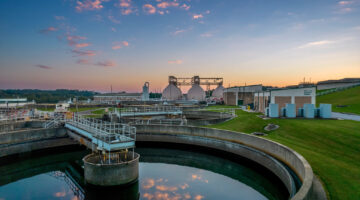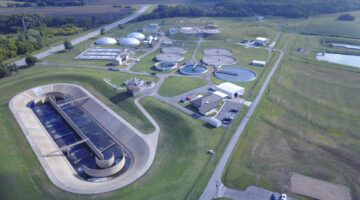The journey to mitigate per- and polyfluoroalkyl substances (PFAS) contamination is a multifaceted endeavor that requires collaboration, innovation and a proactive approach.
In this Q&A article, we delve into the insights and expertise of Caroline Wilson and Lucas Davis, experienced process engineers at Kiewit, as they discuss the opportunities, challenges and best practices for navigating the complexities of PFAS regulations.

What opportunities exist for municipalities as they strive to comply with new PFAS regulations?
Lucas Davis: “A significant challenge in PFAS remediation lies in managing the concentrated waste generated during treatment processes. While removing PFAS from water and wastewater can be complex, the disposal of these residuals presents a particularly unique hurdle. Destructive technologies, though promising, have yet to achieve the commercial viability and scalability needed to address this issue effectively. Current PFAS removal technology generates a concentrated wastewater stream or contaminated media, and the leftover residuals need disposed of. The development of sustainable and effective methods for destroying PFAS residuals remains a critical and exciting area of research and development.”
Caroline Wilson: “I agree. When we look at the disposal side, the distinction between drinking water and wastewater regulation is interesting. Compared to the EPA regulations for PFAS in drinking water, the regulatory landscape for PFAS in residuals remains uncertain. In April, we saw EPA finalize their rule to designate two types of PFAS as hazardous substances under the Comprehensive Environmental Response, Compensation, and Liability Act (also known as Superfund). This action seems like it was intended to target industrial users, and the potential implications for water treatment plants are unclear. This uncertainty could drive innovation and adaptation in the industry, potentially reshaping the landscape of PFAS treatment technologies and what’s perceived as viable.
PFAS sampling presents unique opportunities for innovation as well. The act of PFAS sampling requires extreme care, and even once samples are collected, there are only a limited number of labs capable of performing the analysis at the necessary level of precision. With everyone trying to get their water analyzed simultaneously, turnaround times are becoming increasingly strained. This surge in interest could drive investment in research and development, leading to more efficient and cost-effective methods for PFAS detection.
Lastly, the demand for performance guarantees for PFAS removal equipment present a unique opportunity for manufacturers to differentiate themselves. While we know certain technologies can remove PFAS, securing guarantees for their effectiveness poses a risk, especially when it’s a first-of-a-kind technology for a particular water source. Municipalities don’t want to commit to a solution only to find out later that it doesn’t perform as expected.”
How is Kiewit helping municipalities address PFAS contamination in their water?
Lucas Davis: “Through early engagement in proactive testing and piloting, Kiewit is currently collaborating with two large municipalities on PFAS pilot studies. These controlled site experiments are designed to evaluate and optimize treatment technologies for removing PFAS contaminants. By conducting these studies, we can identify the most suitable approaches tailored to the specific water sources at our treatment plants.
Additionally, we are actively educating ourselves on the latest research and emerging technologies, meeting with vendors, collaborating with industry experts and analyzing the best options to provide effective and economically viable solutions on active projects. There is not a singular solution to this challenge — we all must come together to solve this. While PFAS contamination presents a complex challenge, our collaborative approach to vendors, city staff, and industry experts will foster knowledge sharing and innovation, ultimately driving towards a more sustainable and resilient future.”
Caroline Wilson: “On our present pilot study in the Southeast, our initial discussions focused on examining whether treatment was even necessary. One of the early options we explored was changing the wells from which water is drawn as a solution. For instance, if only a few out of 50 wells have high PFAS levels, could we simply decommission those wells, consider blending, or switching to an alternate source? This approach is crucial, especially when considering the cost of treatment. The answer isn’t always to keep the existing process and just add PFAS treatment — sometimes the solution may look entirely different.
Another advantage Kiewit offers is providing unbiased equipment reviews, unlike technology providers who may perform the piloting themselves. When a technology provider conducts a pilot, there can be inherent biases — whether it’s the ease or cost-effectiveness of procuring certain equipment, or their preference for operating specific technologies. These biases can influence how the data is evaluated, which is why it’s crucial to have an impartial third party involved. Kiewit’s goal is to provide objectively interpreted pilot results, so that the city receives the best possible solution, without being steered in a particular direction for profit-driven reasons.
To build on that point, I think a lot of these emerging contaminant challenges are so complex that it doesn’t make sense for a municipality to be solely reliant on one engineering company. Any company is only looking at the problem through their specific lens — and everybody has their biases. It helps to have multiple minds engaged to identify solutions, which requires a firm that is able to integrate all of those analyses and opinions into one solution that is constructable and operable.
In my experience, Kiewit is great at doing that integration. Because we’ve got the construction piece to complement the design, we’re good at driving towards an end answer, as opposed to giving just consultative opinions that do not translate into execution.”
Lucas Davis: “ — and we’re good at giving an accurate result. A lot of the time, engineers will use factors to come up with construction costs without providing the client with realistic cost information. This causes a major disconnect between what a project will actually cost and what a client thinks it will cost. Having construction integrated with engineering significantly impacts the journey to finding the right solutions.”
What are some of the key factors for a successful PFAS pilot study?
Caroline Wilson: “Data is key.
You must have a lot of data over a long period of time, and you must be really careful with the collection process.
Besides that, when you take a step back and look at the end of the project, it is important to understand the constraints of the municipality. Some of the examples are things such as operator skill level, number of operators and price tolerance — is the owner better able to handle CapEx or OpEx? What disposal option do they have? These considerations are essential for determining which options to test, so we can develop a solution that is both technically effective and practical for their specific situation.”
What advice do you have for municipalities on the fence about when to start addressing PFAS?
Lucas Davis: “It must be addressed sooner rather than later, but due diligence is required — such as piloting different types of treatment, which will be essential to choosing the right technology. They need to figure out what will be the best treatment solution for them.
Based on the regulatory rollout, cities across the United States are going to be forced to address PFAS at the same time. Getting in line early with data ready will be critical.”
Caroline Wilson: “That’s exactly what I was going to say. Knowledge is power. Just like knowing what’s going on in the world around us, municipalities should not be afraid to get that initial data they need so they are knowledgeable about the best way to treat PFAS at their plant.
Cities will be competing for limited resources, whether that’s labs, engineering firms, contractors or even regulators to review their applications. There is going to be a lot of stuff happening at once. The more proactive they can be, the better.”
Lucas Davis: “I would love to see municipalities proactively solve the challenge together. What if ten regional facilities partnered with one vendor, and each facility had water trucked into that vendor’s plant to pilot different technologies with various sources? This common pilot location might be more economical than placing pilot plants all over United States.
Speaking of improved economics, will regional PFAS treatment be a viable solution? Meaning, can PFAS destruction facilities be regional or centralized instead of decentralized, to reduce economic impacts on surrounding cities? In lieu of having dedicated solutions at each facility, cities alike may benefit from having a centralized facility that takes in waste from the surrounding counties and treat it from one location.”
Caroline Wilson :“Almost like the way that IX resin is often regenerated in centralized facilities rather than regenerating at each plant that uses the resin.”
Do you see any trends in PFAS treatment technologies?
Caroline Wilson: “There’s obviously a lot of momentum around established technologies, such as IX resins or granular activated carbon (GAC). Another intriguing perspective is looking at the waste. Specifically, what actually happens to the PFAS-laden media? Incineration is a regeneration technique for granular activated carbon which would allow it to be used again. But does the PFAS get into the stack gas? I think that’ll be really important research so we can understand the downside of these existing technologies better.
As we get more comfortable with PFAS-removal technologies, I think the next trend will be to dedicate more brain power on residuals. What happens to the waste streams created from these removal technologies? The answer to that question will inform which technologies win the race. Right now, we know IX and GAC are established technologies that can tackle the problem, and there are not a lot of restrictions on disposing of their spent media. But if landfills close off receiving those waste streams, that might greatly change what technologies are seen as viable.”
How can municipalities develop adaptable water treatment infrastructure to address future contaminant threats? Is there any advice we can give municipalities about how they can expand and adapt their facility?
Lucas Davis: “Future expansion is a critical part of this regulation change. Cities will continue to grow — some at a fairly rapid rate. Keeping basic factors at the top of our minds is important, such as land for growth. If no land is available, technologies with smaller footprints need to be considered.”
Caroline Wilson: “Agreed! In addition to leaving real estate open, it’s a good idea to leave piping provisions and electrical capacity for future additions. As hard as we all try to keep a pulse on where the industry is heading, we can never predict exactly what’s going to happen in this regulatory landscape.
When I think about expansion, a couple other items come to mind. While not an option for all cities, having multiple water sources can help. If your city has one treatment plant or single source of water, they are more vulnerable to something being wrong with that single source. The simple solution can be to address your treatment portfolio through diversification over time, rather than waiting until there’s a problem with your only water supply.
Secondly, membrane treatment can really be a catch-all for a lot of contaminants, including PFAS. Membrane treatment takes more energy than traditional equipment technologies like media filters, but it would give municipalities more flexibility in their ability to address future contaminants.”
As municipalities face the challenge of evolving PFAS regulations, Kiewit’s process engineers provide trusted insights and proven solutions. From piloting advanced treatment technologies to offering unbiased, expert advice, we’re ready to support your next steps. Contact Kiewit today to discuss your PFAS needs and explore how we can help you navigate these regulations with confidence.
About the authors: Lucas, department manager of Kiewit’s process engineering group, specializes in complex industrial and water projects. With a focus on technical oversight, he collaborates with clients to develop efficient and cost-effective solutions. Caroline is a lead process engineer working as part of Lucas’s department, where she specializes in designing water treatment systems. With expertise in process calculations, flow diagrams, and equipment specifications, Caroline supports projects from design to construction. She also manages vendor contracts, develops testing procedures, and oversees field operations.


